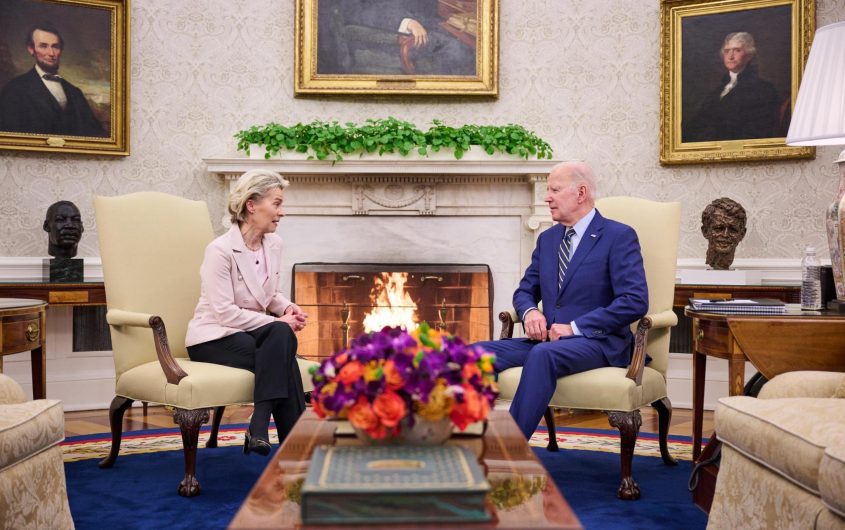
Dati Bendo via European Union, 2023
A Transatlantic Display of Trade Policy’s Future

Peter S. Rashish
Vice President; Director, Geoeconomics Program
Peter S. Rashish, who counts over 30 years of experience counseling corporations, think tanks, foundations, and international organizations on transatlantic trade and economic strategy, is Vice President and Director of the Geoeconomics Program at AICGS. He also writes The Wider Atlantic blog.
Mr. Rashish has served as Vice President for Europe and Eurasia at the U.S. Chamber of Commerce, where he spearheaded the Chamber’s advocacy ahead of the launch of the Transatlantic Trade and Investment Partnership. Previously, Mr. Rashish was a Senior Advisor for Europe at McLarty Associates, Executive Vice President of the European Institute, and a staff member and consultant at the International Energy Agency, the World Bank, UN Trade and Development, the Atlantic Council, the Bertelsmann Foundation, and the German Marshall Fund.
Mr. Rashish has testified before the House Financial Services Subcommittee on International Monetary Policy and Trade and the House Foreign Affairs Subcommittee on Europe and Eurasia and has advised three U.S. presidential campaigns. He has been a featured speaker at the Munich Security Conference, the Aspen Ideas Festival, and the European Forum Alpbach and is a member of the Board of Directors of the Jean Monnet Institute in Paris and a Senior Advisor to the European Policy Centre in Brussels. His commentaries have been published in The New York Times, the Financial Times, The Wall Street Journal, Foreign Policy, and The National Interest, and he has appeared on PBS, CNBC, CNN, NPR, and the BBC.
He earned a BA from Harvard College and an MPhil in international relations from Oxford University. He speaks French, German, Italian, and Spanish.
Since U.S. Treasury Secretary Janet Yellen’s speech last spring calling for the United States to achieve “free and secure trade…with the countries we know we can count on” the notion of “friendshoring” has looked set to become the guiding principle of U.S. trade policy. And with last Friday’s meeting at the White House between President Biden and European Commission President Ursula von der Leyen the idea has now been turned into action.
This display of trade policy’s future was the result of efforts to respond to EU objections about sourcing language in the U.S. Inflation Reduction Act (IRA) passed by the Congress last August. According to the law, critical minerals used in electric vehicle (EV) batteries need to be produced in the United States or come from countries with which it has a free trade agreement to be counted toward tax credits for consumer EV purchases.
While the United States and the European Union have maintained a bilateral cooperation platform since September 2021 through their Trade and Technology Council, they do not have a free trade agreement like the U.S.-Mexico-Canada Agreement that replaced NAFTA. In the absence of such an agreement, EU governments became concerned that their companies might move production to the United States to qualify for favorable IRA treatment.
The U.S.-EU critical minerals agreement is a win-win-win for the climate, U.S. and EU security interests, and the rules-based trading system.
At their meeting, the two presidents committed to reaching a U.S.-EU “targeted critical minerals agreement” that would allow the European Union to qualify as a free trade agreement partner for the purposes of the IRA. Under the agreement, the two sides will pursue “cooperation on diversifying critical mineral and battery supply chains, recognizing the substantial opportunities on both sides of the Atlantic to build out these supply chains.” It will also serve to “further our shared goals of boosting our mineral production and processing and expanding access to sources of critical minerals that are sustainable, trusted, and free of labor abuses.”
With this agreement, the two transatlantic economic powers have achieved a win-win-win for the climate, U.S. and EU security interests, and the rules-based trading system.
Climate. By allowing EU critical minerals to be included on an equal footing with those from the United States, the deal struck on Friday will help ensure that U.S. electric vehicle producers have a supply of manufacturing inputs available to them that is larger and probably more cost-efficient in the short term as well as being more resilient in the long term. These benefits should facilitate the production of EVs and their uptake by consumers, helping the United States to meet its decarbonization goals under the Paris Agreement.
U.S. and EU security interests. Not only did the Biden-von der Leyen deal ease transatlantic climate-related frictions, which should help them achieve a future deal on fair and sustainable steel and find a modus vivendi following the introduction of the EU’s Carbon Border Adjustment Mechanism. It also promotes their common external security by reducing their dependence on Chinese supply chains for critical minerals—some of which have defense applications—and denying Beijing the ability to turn those flows on and off to its advantage.
The rules-based trading system. This step by the United States and the European Union will be consistent with World Trade Organization (WTO) rules. Its Article XXIV requires a bilateral agreement to cover “substantially all trade”—but only when it includes tariff reductions, which are not part of the critical minerals agreement. Additionally, the EU is now unlikely to bring a dispute settlement case in the WTO against the IRAs’ sourcing requirements. That will help buttress the multilateral trading system, since a ruling against the IRA could delegitimize the WTO in Washington at a time when U.S. support is needed for efforts to update its rules to accommodate greater climate action.








